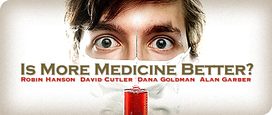I suggested supply-side differences might explain aggregate differences in how we ‘produce’ health. Robin Hanson replied that he would like to see the system become more efficient. But what if the regional differences are due to demand-side factors? Maybe people in Miami prefer surgery, and people in Minnesota prefer medical management. In that case, retooling by fiat would result in a loss of welfare (although not necessarily in health). The point is that we need to understand whether it is demand or supply-side factors driving these differences in aggregate outcomes.
If it is merely a matter of retooling the system to get cheaper at producing health, then I suspect we are all in agreement. The real question is how we get there. If we merely raise prices, what is to prevent us from returning to this equilibrium a few years later? I believe insurance and tax reform — of the sort already mentioned — combined with financial incentives linked to outcomes assessment could get us there.

